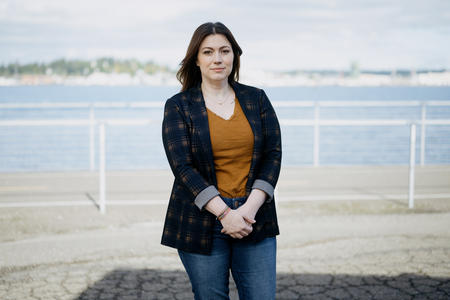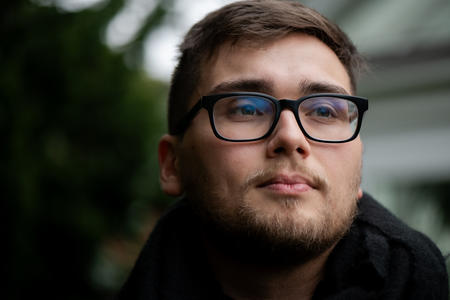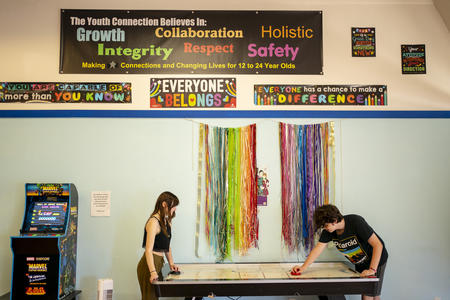Listen to a related podcast on this story here:
Janell’s voice trembled as she recalled that moment, her belief that it was all her fault, and the fear she felt for her little brother.
For Janell, now 30, that day launched her into more than a decade of near-constant uncertainty in the foster care system and beyond. She shuffled among relatives and foster homes for years, sometimes with her younger brother and at other times separated. Placements often strained her family and cultural connections, and she struggled to prepare herself financially for adulthood.
Today, she is still healing from all of it — not just the instability she faced, including a stretch of homelessness, but also the ways she feels the system failed her family. She hopes to use her experience to help others avoid the same pains.
“If my story can help anyone, just even one person,” she said, “then that’s all that matters to me.”
This article and podcast is part of an ongoing series on homelessness in Washington state, done in collaboration with Youth Today. It is made possible in part by support from the Raikes Foundation. Youth Today and Crosscut maintain editorial control. You can read more stories from this series here.
In 2018, the Washington State Legislature passed a law aimed at ensuring no young people bec0me homeless after leaving public systems such as foster care, juvenile detention or inpatient behavioral health treatment. The law set December 2019 as a deadline.
Nevertheless, at last count, in 2021, one in six young people in Washington were homeless a year after leaving a state-run system, including 38 out of the 188 youth who exited foster care that year. Since then, newer prevention efforts have rolled out, with mixed results. Although the comparison is not exact, one recent study found that youth involved in foster care in Washington were two to four times more likely than their peers to face homelessness or housing instability. Critically, Black and Indigenous youth — Janell identifies as both — are overrepresented among both foster and homeless youth.
Janell Braxton, photographed here outside the apartment building she has lived in for four years, grew up in and out of the foster system and is now working to help other youth aging out of the system. “Figuring out who you are as a young person is hard. And to have to figure it out while you’re transitioning or moving or going through all these things is even harder,” Janell said. “I kind of lost who I was.” (Genna Martin/Crosscut)
National figures paint a similarly stark portrait. A 2015 study that surveyed 600 homeless youth in three U.S. cities found that over a third of them had been in the foster care system, and had endured homelessness for longer periods than non-foster youth. The authors questioned whether certain “youth received necessary and effective services while in foster care to help them establish sustainable and safe relationships and living situations upon exit.”
The percentage of Indigenous youth in foster care nationwide is three times that of the percentage of Indigenous youth in the general population; for Black children, it’s 1.65 times the percentage.
As a young child, Janell and her family — an older brother and older sister, her younger brother, and their parents — lived for a time with her paternal grandmother. Both her mother and father struggled with alcoholism, compounded by her father’s repeat arrests and her mother’s mental health issues. Sometimes the family stayed in shelters, moving between Seattle and Everett. When a shelter would not admit men or older teenagers, her dad and older brother slept in a car. Eventually, the family secured a three-bedroom apartment.
Janell still keeps an album that a foster sister made for her years ago. In it is a photo of her parents on their wedding day. Her mother sports a baby bump — her younger brother — and Janell herself is a toddler. In a chilly study room at a branch of the Seattle Public Library, she recently flipped through the pages of family photos and handwritten notes.
“To me, home was never a place,” she said. “It was always where my family was.”
Washington has the eighth-highest rate of disproportionality for American Indian/Alaska Native foster children in the country, according to a 2021 fact sheet from the National Indian Child Welfare Association. That report also cited research showing that Black and Indigenous families are twice as likely as white families to be investigated by social services, with their children three or four times more likely to be placed in foster care.
Not long after Janell’s family moved into their apartment, the state began investigating her parents, sparked by reports of homelessness and school absences, according to Janell’s mother, Debra Braxton. Ultimately, officials put Janell and her younger brother in foster care.
Moving in with her first foster family felt jarring, Janell said. She had her own room for the first time, but felt unused to the schedule that the family kept and the food they ate. Unlike her, they were white. She felt lucky, though: She and her younger brother had been placed in the same home.
Less than a year later, she returned from summer camp to find her brother gone. He had left to live with their paternal grandmother. When her foster mother asked if she wanted to go too, “I was like, ‘Well, yeah, of course!’” Janell recalled.
But Janell said she struggled in her grandmother’s strict household, especially “unfair punishments” that took a toll on her mental health. More than once, Janell harmed herself and landed in Seattle Children’s Hospital. Eventually, a social worker there asked her if she felt safe with her grandmother. She responded no.
She went to live with a new foster family — this time without her brother, who remained with their grandmother. It would be a year before she would see him again.
In her next foster home, Janell flourished. They had a giant backyard. Her foster grandparents bought her a viola, which she played in the school orchestra, and taught her to play piano. They encouraged her love of math, a subject she said soothed her with its clear answers.
But her foster father was “creepy,” Janell said. After Janell told Debra, whom she saw in monthly supervised visits, Debra helped Janell call a social worker. Soon, Janell packed her belongings into black trash bags and moved again.
As Janell bounced among homes, Debra got sober and went to Alcoholics Anonymous. She took parenting classes, got counseling and found housing — often seeking Child Protective Services-approved services herself, she said. She and Janell’s father separated.
All of it, she told Crosscut and Youth Today, was “for the kids,” but despite her efforts, she felt that the state was telling her, “You’re never good enough. You didn’t complete enough.”
“Well, I’d done all I could think I could do,” she said. After a decade, a judge allowed her younger son to return to live with her.
Janell and Debra both said they wished that they’d been given the option of family reunification counseling after she left foster care. If they had, Janell said, her family could have begun talking about hard truths and learning to cope and to grieve together. They might have begun healing together sooner, too.
“It would have helped me shift my perspective of ‘Oh it’s just about me’ to ‘This happened to us all,’” she said. It took her years to be able to talk about her experiences with her mother and her father, who has since passed away, because she didn’t know how.
In a court hearing when Janell was 14 or 15, Debra asked Janell if she wanted to live with her again. Janell, eyeing scholarships for which she’d been told she would qualify if she stayed in foster care, said no. She figured that once she turned 18, she could see her mother whenever she wanted.
“I think I kind of broke her heart a little bit by saying that,” Janell said.
When Janell was 17, she moved again, this time to live with her older sister, who had obtained her foster care license. But they clashed often, and after a year and a half, Janell moved out.
She entered Extended Foster Care, which gave her the option to live on her own, and enrolled simultaneously in Independent Living, a state program that is contracted out to community organizations. Janell’s Independent Living case manager helped her find an apartment and handled the logistics of paying rent.
Janell said she appreciated having her rent covered, but regretted not gaining direct experience with renting an apartment. She also wished she had learned how to open a bank account, save money, avoid overdraft fees and develop other skills like knowing what questions to ask when searching for a doctor or buying insurance — to become comfortable with these tasks at a time when it would be safe to make mistakes and learn from them, before they would become too costly.
Some research indicates that programs like Washington’s Independent Living “are not effective in meeting the needs of youth in foster care” because they are too “generic” and don’t offer “concrete and specific information that would be useful in procuring services. Other studies have suggested that while participants can benefit from these programs, they still need more support.
Washington has tried to close this gap, launching services like Lifeline WA, a pilot program aimed at helping former foster youth. Janell said she wished that something like it had existed for her back then, because she would have called it and asked for help and for answers to her myriad questions.
After settling into her own apartment, Janell suffered additional upheaval when a sexual assault there left her feeling shaken and unsafe. She did not want to live there anymore, but she didn’t understand how to look for an apartment herself, and wasn’t ready to live alone.
Janell Braxton takes notes during a Zoom meeting with the Department of Children, Youth and Families Adolescent Transition board she sits on, Oct. 31, 2023 at the Lake City Public Library. Currently a volunteer on the board, she hopes to one day have a full-time position with the department. (Genna Martin/Crosscut)
For a few weeks she lived with her biological dad, then began moving around, crashing on different relatives’ couches. Occasionally she stayed with her mother, but could never stay long without risking jeopardizing her mother’s housing voucher. She counted herself lucky that during this stretch of homelessness, which lasted for the better part of five years, she never slept on the street.
State programs like Independent Living, intended to prepare her for independence, hadn’t truly done so before she aged out of services, she said.
“They just don’t care anymore,” she said. “They drop you and it’s like, ‘Well, here, welcome to homelessness,’ and that part sucks.”
The Department of Children, Youth and Families, which oversees foster care in Washington, declined to comment on Janell’s case, citing confidentiality requirements. But spokesperson Jason Wettstein acknowledged that “we have more work to do to make sure that Extended Foster Care prepares youth for life beyond foster care.”
“It provides them with financial assistance, but not enough,” he told Crosscut and Youth Today via email. “It provides youth with essential services, but only some of the support they need to successfully transition out of foster care. We are working to change that.”
Wettstein wrote the department is also “doing more to ensure transition planning meets young people’s needs,” citing an ongoing redesign of its transition process, including Independent Living.
As Janell slept on couches — a situation not always counted in tallies of youth homelessness, Alice Huber, director of Research and Data Analysis at the Department of Social and Health Services, told Crosscut and Youth Today via email — she began struggling elsewhere in her life. She had enrolled in college to pursue a journalism degree in 2017, but a year later she put her studies on hold. Housing instability made it difficult to concentrate on school, she said.
Four years ago, Janell qualified for temporary rental assistance through the state’s Housing and Essential Needs program. Every day for several months, she searched for an apartment, until she found a studio in a complex that accepted the program’s payments. She eventually also qualified for federal disability benefits.
Today Janell lives in a one-bedroom apartment in the same complex, with her partner, two cats and a husky who follows her everywhere. She sits on a statewide advisory board to the Department of Children, Youth and Families. In 2021 she won a fellowship at the publication The Imprint, where she wrote articles about how the foster care and juvenile justice systems increased youth homelessness, the importance of sibling relationships in foster care and the process of finding one’s cultural identity.
She hopes to apply for a job with the Department of Children, Youth and Families and to resume her journalism degree next year. She continues attending gatherings with members of her tribe, the Qawalangin, of which she is an enrolled member, and hopes to learn the language.
Last year Janell finally began unpacking her clothes and belongings from the trash bags and boxes in which she’d been storing them for years, dogged by a feeling that she would soon move again. She said she is now in the process of decorating, putting up art and making lists of things she’d like to have: curtains, rugs, a bath mat. She still has, and cherishes, the viola from her foster grandparents, which she plays a few times a month.
And she said she has begun to understand herself after years of trying to be a “chameleon” and a “people-pleaser” who cast aside her own needs and desires.
“Figuring out who you are as a young person is hard. And to have to figure it out while you’re transitioning or moving or going through all these things is even harder,” Janell said. “I kind of lost who I was.”
Over time, Janell also began healing. When she was 17 she became involved in the Mockingbird Society, a youth advocacy organization, where she gradually learned to talk about her experiences and process them.
“I didn’t realize how therapeutic it was going to be to share my story until I did it,” she said. The first few times she shared, she sobbed. Today she still cries — the memories remain raw — but “it’s good tears,” she said. “It’s like a sense of relief.”
After many painful years of each trying to understand what the other went through, Janell and Debra now see each other weekly and celebrate birthdays and holidays together with her siblings. Janell will bake and decorate a cake, and they’ll play games, watch a movie or chat. Their relationship is the kind in which Janell can call Debra in the middle of the night if she needs to, and Debra will answer.
Youth Today is a nonprofit, independent news site for people who care about and work with children and youth. Subscribe to Youth Today’s free monthly newsletter.













